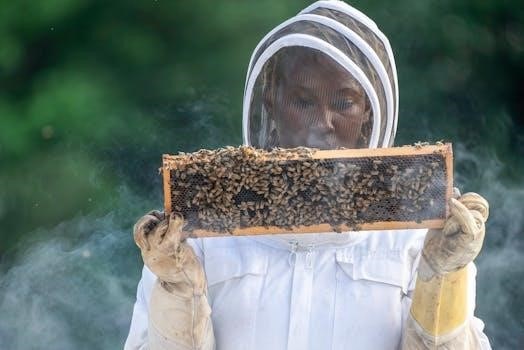Summary of The Secret Life of Bees
Sue Monk Kidd’s novel, set in 1964 South Carolina, tells the story of Lily Owens, a fourteen-year-old girl haunted by her mother’s death. Seeking solace, she runs away with Rosaleen and finds a new family with the Boatwright sisters, who are beekeepers.
Plot Overview
The narrative begins with Lily Owens, a young girl living in Sylvan, South Carolina, in 1964. She is burdened by the accidental death of her mother and the abuse she suffers from her father, T. Ray. Lily’s life takes a turn when her black caregiver, Rosaleen, is attacked after attempting to register to vote. This incident prompts Lily to run away with Rosaleen. They embark on a journey to Tiburon, South Carolina, a town Lily believes holds the key to her mother’s past. Lily’s quest to discover more about her mother, Deborah, leads her to the Boatwright sisters, three African American women, who are beekeepers. Their home offers her a new sense of belonging and a safe haven from the outside world, where she begins to heal from past traumas and learns about the importance of bees and the divine feminine.
Lily Owens’ Journey
Lily’s journey is a coming-of-age story fueled by a desperate need for love and understanding. Haunted by the memory of accidentally killing her mother, she carries a heavy burden of guilt and loss. Her abusive father, T. Ray, only exacerbates her pain, leading her to seek refuge elsewhere. Lily’s escape to Tiburon is not just a physical journey; it’s a spiritual quest to uncover her mother’s identity and find a place where she truly belongs. As she integrates into the Boatwright sisters’ lives, Lily learns about beekeeping, the divine feminine, and most importantly, herself. Her time with the sisters becomes a transformative period where she begins to heal from her past traumas and confront the harsh realities of racism and violence in the South during the Civil Rights era.
The Boatwright Sisters
August, May, and June Boatwright are a trio of extraordinary African American sisters who provide sanctuary and guidance to Lily. They are beekeepers with a unique spiritual practice centered around a statue of the Black Madonna. August, the eldest, is wise, nurturing, and serves as a maternal figure to Lily. May, emotionally sensitive, carries the weight of the world’s sorrows. June, initially resistant to Lily’s presence, is an independent woman involved in the civil rights movement. The sisters’ home is a haven, filled with warmth, love, and the comforting hum of bees. They teach Lily about the importance of community, the divine feminine, and the power of forgiveness. Their collective wisdom and support become crucial for Lily’s healing and growth, forming the found family she desperately craves.

Themes in The Secret Life of Bees
This novel explores motherhood, loss, identity, belonging, racism, and the divine feminine. It delves into the search for love, acceptance, and the complexities of the human experience during the civil rights era.
Motherhood and Loss
The core of “The Secret Life of Bees” is deeply rooted in the themes of motherhood and loss, primarily through Lily’s experiences. Her life is defined by the accidental death of her mother, Deborah, a tragedy she believes she caused at the tender age of four. This loss leaves her with a profound sense of guilt and an unyielding yearning for maternal love. Lily’s search for her mother becomes the driving force behind her actions, leading her on a journey to uncover the truth about Deborah. The absence of a nurturing maternal figure shapes her identity and her relationships, especially with her abusive father, T. Ray. The novel also explores different forms of motherhood, including the nurturing presence of Rosaleen and the unconventional matriarchy of the Boatwright sisters. Lily’s journey is not just about finding her mother; it’s about discovering different kinds of motherly love and healing from the pain of loss. It is about understanding that love and care can be found in unexpected places and through different relationships.
Identity and Belonging
The search for identity and a sense of belonging is another key theme in “The Secret Life of Bees,” particularly for Lily Owens. Growing up with a harsh and neglectful father, Lily struggles to understand her place in the world and her own identity. She is haunted by the circumstances of her mother’s death and carries a deep-seated belief that she is unlovable and unworthy. Her journey to Tiburon is not just a search for her mother, but also a quest to find a place where she truly belongs. Through her interactions with the Boatwright sisters, she begins to redefine her identity, discovering strength, resilience, and the power of female community. She learns about her mother’s past and the connections she shared with the sisters, which helps her understand herself. Lily’s experiences with the Daughters of Mary and the diverse community in Tiburon teach her that belonging can be found in unexpected places and through shared experiences.
Racism and Civil Rights
Set in South Carolina during the Civil Rights Movement, “The Secret Life of Bees” confronts the pervasive racism of the 1960s American South. The novel portrays the stark realities of segregation and racial prejudice through the experiences of its black characters, particularly Rosaleen and the Boatwright sisters. Rosaleen’s act of defiance against racist white men sets the stage for Lily and Rosaleen’s escape to Tiburon. The novel explores the ways in which racism shapes the characters’ lives, limiting opportunities and perpetuating violence. Despite the overt racism they face, the black characters create a sense of community and find strength in their shared experiences. Lily, as a white girl, begins to confront her own biases and learn about the impact of racism on others, experiencing prejudice firsthand through her interactions with Zach. The novel is a reminder of the struggles for equality and the importance of empathy in overcoming prejudice.
The Divine Feminine
“The Secret Life of Bees” explores the concept of the divine feminine through the lens of the Boatwright sisters’ unique religious practices. They worship a Black Mary statue, viewing her as a source of comfort, strength, and divine love. This representation challenges traditional patriarchal views of religion and emphasizes the nurturing, compassionate aspects of the divine. The sisters’ interconnectedness and their reliance on female wisdom demonstrate a powerful alternative to the masculine-dominated world that Lily has always known. The novel also draws parallels between the life cycle of bees and the feminine principle, highlighting the importance of community, cooperation, and nurturing. Lily’s journey towards self-discovery is intertwined with her understanding of the divine feminine, showing the positive power of female role models and spiritual guidance. Through these elements, the book proposes a more inclusive and holistic view of spirituality;

Key Characters
The novel features memorable characters like Lily Owens, a young girl seeking her mother; Rosaleen, her strong caregiver; August Boatwright, a wise beekeeper; and T. Ray, Lily’s abusive father.
Lily Owens
Lily Owens, the protagonist of “The Secret Life of Bees,” is a fourteen-year-old white girl living in South Carolina in 1964. She is deeply affected by the accidental death of her mother when she was four years old, an event she believes she caused. Lily’s life is marked by a yearning for maternal love and a search for her mother’s past. She suffers under the neglectful and abusive care of her father, T. Ray, which further fuels her desire to escape her current circumstances. Lily is portrayed as a lonely and unpopular teenager, longing for belonging and understanding. Her journey is one of self-discovery and healing as she seeks the truth about her mother and her own identity. Lily’s resilience and determination are evident as she embarks on her quest, ultimately finding solace and a sense of family with the Boatwright sisters.
Rosaleen
Rosaleen is a pivotal character in “The Secret Life of Bees,” serving as Lily Owens’s fierce and devoted caregiver. A Black woman in 1964 South Carolina, Rosaleen provides Lily with the maternal love and support that she lacks from her own family. Rosaleen is described as courageous and strong-willed, often standing up for what she believes is right, even in the face of racial prejudice. Her actions, particularly when she insults a group of racist men, set the events of the novel in motion, prompting her and Lily’s escape. Rosaleen’s character embodies resilience and unwavering loyalty. She acts as a stand-in mother for Lily, offering guidance and protection. She also contributes to the story’s exploration of racial tensions and the fight for civil rights. Rosaleen’s influence shapes Lily’s journey and her understanding of the world around her.
August Boatwright
August Boatwright is one of the three Boatwright sisters and a central figure in “The Secret Life of Bees”. She is a wise and nurturing woman who runs a successful beekeeping operation in Tiburon, South Carolina. August is depicted as a spiritual and compassionate woman who embodies the divine feminine, and her home becomes a sanctuary for Lily and Rosaleen. She is knowledgeable about beekeeping, which she uses as a metaphor for life and community. August’s character is characterized by her patience, grace, and her unique way of understanding the world. She is also a strong advocate for the Black community, as well as a leader of the Daughters of Mary. Her guidance helps Lily uncover the truth about her mother, Deborah. August is a source of comfort, wisdom, and love.
T. Ray
T. Ray Owens is Lily’s abusive and emotionally distant father in “The Secret Life of Bees.” He is a peach farmer in Sylvan, South Carolina, and is depicted as a harsh, bitter, and unforgiving man. T. Ray is neglectful and often cruel to Lily, blaming her for the accidental death of her mother, Deborah. His inability to cope with his grief over his wife’s death leads to his abusive behavior. T. Ray represents the damaging effects of unresolved trauma and toxic masculinity. He is a constant source of unhappiness for Lily, driving her to seek refuge elsewhere. He is often shown as an unloving parent who is incapable of expressing affection. T. Ray’s character serves as a foil to the nurturing figures that Lily encounters in Tiburon, emphasizing the importance of love and support.

Adaptations
The popular novel “The Secret Life of Bees” was adapted into a 2008 American drama film. The film features a star-studded cast and was directed by Gina Prince-Bythewood.
Film Adaptation
The 2008 film adaptation of “The Secret Life of Bees” brought Sue Monk Kidd’s beloved novel to the big screen, captivating audiences with its powerful storytelling and stellar performances. Directed by Gina Prince-Bythewood, the movie features Dakota Fanning as Lily Owens, a young girl searching for answers about her mother’s past, and Queen Latifah as August Boatwright, one of the beekeeping sisters who offers Lily refuge. The film also stars Jennifer Hudson as Rosaleen, Lily’s caregiver, and Alicia Keys as June Boatwright. This adaptation beautifully captures the essence of the novel, exploring themes of motherhood, identity, and the complexities of race relations in the 1960s American South. It provides a visual representation of the novel’s rich characters and emotional depth, making it a popular choice for both fans of the book and new viewers.

Additional Resources
For a deeper understanding of “The Secret Life of Bees,” numerous study guides and analyses are available. These resources offer summaries, character breakdowns, and thematic explorations, enhancing your reading experience.
Study Guides and Analyses
Numerous resources exist to aid in understanding “The Secret Life of Bees,” offering comprehensive study guides and detailed analyses. These guides delve into the novel’s intricate plot points, exploring Lily’s emotional journey and the complexities of her relationships with the Boatwright sisters. They often include character analyses, examining the motivations and development of key figures like Lily, Rosaleen, and August. Furthermore, these resources provide thematic explorations, dissecting the novel’s core ideas about motherhood, identity, and racism in the 1960s South. Many also feature chapter summaries, offering a concise overview of each section, and quote analyses, explaining the significance of the novel’s most memorable passages. These study aids often come with quiz questions to test comprehension and facilitate a deeper engagement with the text. This wealth of materials helps both students and avid readers to fully grasp the beauty and complexity of Sue Monk Kidd’s work.